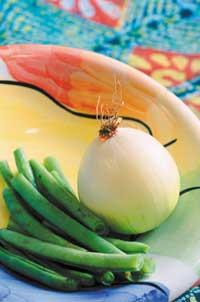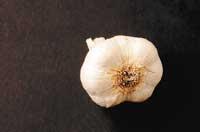Onion
The onion is the bulb of the plant that bears the same name (Allium cepa). This bulb is not a root, as many believe, but a thickened stem under the ground. The true root is formed by filaments that are born below the bulb. It is sown in temperate climates and the main producing countries of the world are China, India, United States, Russia, Japan and Spain.
Since Egyptian times the medicinal properties of onions are known. 3,500-4,000 years ago, the participants in the construction of the pyramids ate the onion, and not for its kilocalories, but to cure bronchitis and pneumonia that were captured working.

Onion has very few kilocalories: 38 kcal/100 g. Most of the energy comes from carbohydrates: glucose, sucrose and others, which make up 6.83% of the onion. Its protein content is low (1.16%) and practically zero (0.16%).
It contains practically all mineral salts and vitamins, although in small amounts, except for vitamin B12, highlighting its content in potassium (157 mg/100 g) and sulfur.
But the most outstanding are non-nutritious substances that cause an important physiological activity in the body. For example, essential oils, responsible for that characteristic smell of onions. It is a very volatile oil with a complex composition. It contains more than 100 different substances, including alyl disulfide and thiosulfinate. Flabonoids are glycosidic substances that facilitate blood circulation. They prevent cocules and prevent oxidation of low-density lipoproteins that cause atherosclerosis. The most active flabonoid is queritrine.
In fact, the most important properties of onion are attributed to essential oils and flabonoids, which make it antibiotic, antiasthmatic, diuretic, antitumor and protector of hearts and arteries.
Because this essential oil is very volatile, it quickly permeates the body tissues, so it affects several organs. The following are the scientifically proven effects so far:
Respiratory problems
Components with essential oil sulfur immediately pass into the stomach into the blood and are expelled from the lungs. Therefore, within minutes of eating the onion, the breath acquires a characteristic smell. Mucolytic onion (breaks down thick mucus), expectant (facilitates the expulsion of bronchial mucus), and antibiotic. All respiratory infections (sinusitis, bronchitis, pneumonia...) improve with the administration of onions and asthma itself thanks to thiosulfinate.
Atherosclerosis and arterial problems
Several studies show that onion kercin prevents arterosclerosis and thrombosis, as it improves blood circulation.
Kidney problems
Increases the volume of urine and facilitates the removal of acid residues. That is why it is said to have an alkalizing effect. It is recommended to eat a lot of onion to people with stones or kidney infection.
Liver disorders
Promotes the decotoxifying function of this organ. In case of chronic hepatitis or cirrhosis it is highly recommended.
Cancer
A study in China found that those who ate a lot of onions and garlic are at less risk for stomach cancer.
To achieve this, it is ideal to eat raw onions, except those with gastric ulva or gastritis. The latter should eat cooked or roasted onions. To eat raw it is convenient to add a few drops of lemon. Cooking facilitates consumption, but reduces medicinal effects. It should be cooked in a very short time (less than a minute) to avoid as much as possible the effects and take broth to also take advantage of its properties. Burning is also sweet, but the longer it burns the less medicinal effects.
Scallions (Allium fistulosum) Species located between the onion and the leek. The onion is more tender than normal and, in addition to bulb, leaves and stem are consumed. It contains the same nutrients and medicinal substances as onion, but at a lower concentration. It can be taken in raw salad or with other meals (tortilla...). |
Garlic
Garlic (Allium sativum) is the best friend of onion, as it is normally used together in the kitchen, and is considered curative against seven diseases.

It has been used as medicinal for more than five thousand years. It has its origin in Asia and is mainly sown in hot lands.
Being of the genus Allium, it is rich in essential oils with sulfur and is used against various diseases: antibacteria, regulation of blood pressure, decreased levels of cholesterol and blood sugar, improvement of blood circulation, cancer, etc.
For all the above, we invite you to use onion and garlic in the preparation of any food (salads, vegetables, legumes, meat, fish, tortillas...). That these two are not lacking in our kitchens for the benefit of health.





